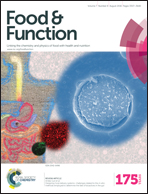Malondialdehyde and 4-hydroxy-2-hexenal are formed during dynamic gastrointestinal in vitro digestion of cod liver oils
Abstract
Marine long-chain polyunsaturated fatty acids (LC n-3 PUFA) are associated with reduced risk for inflammatory diseases, such as cardiovascular diseases and rheumatoid arthritis. These fatty acids, however, are rapidly oxidized, generating highly reactive malondialdehyde (MDA), 4-hydroxy-2-hexenal (HHE) and 4-hydroxy-2-nonenal (HNE). These oxidation products may interact with DNA and proteins, thus possibly leading to impaired cell functions. Little is known about the formation of MDA, HHE and HNE in fish oil in the gastrointestinal (GI) tract. In this study, the effect of dynamic in vitro digestion of cod liver oil on the generation of MDA, HHE and HNE was evaluated using the TNO Gastro-Intestinal Model (tiny-TIM). Effects of pre-formed oxidation products, pre-emulsification of the oil, and addition of oxidants (EDTA and hemoglobin, Hb) on GI oxidation were evaluated. Formation of aldehydes occurred during GI digestion. However, only emulsified oil fortified with 11.5 μM Hb oxidized to a degree that overcame the dilution induced by gastric secretion, which caused increased aldehyde concentrations in gastric lumen up to 90 min. The maximum levels of aldehydes generated in this study were 24.5 μM MDA, 1.6 μM HHE and 0.07 μM HNE. Oils containing different amounts of pre-formed lipid oxidation products maintained the same oxidation ranking order during digestion, even though the relative changes were not directly proportional. Emulsification of the oil had an unclear effect in the gastric phase, but a pro-oxidative effect in the intestinal phase. In general, higher aldehyde levels were reached in the intestinal lumen than in the initial meal, demonstrating that GI digestion promotes oxidation. Hence, epithelial cells may be exposed to elevated amounts of reactive aldehydes for several hours after a meal containing fish oil.



 Please wait while we load your content...
Please wait while we load your content...